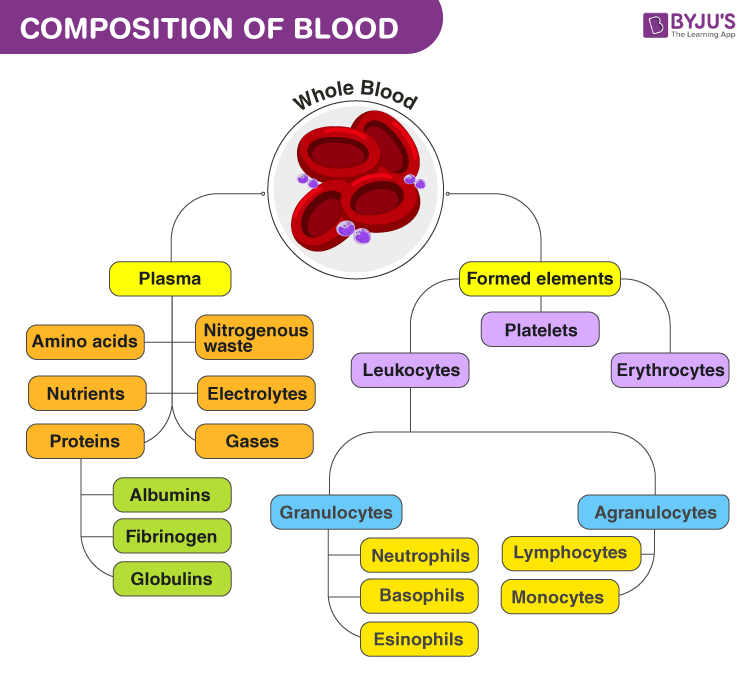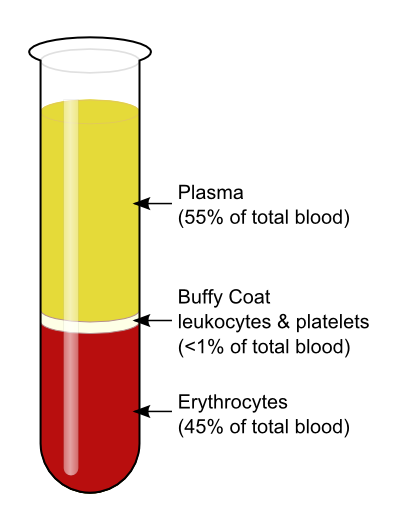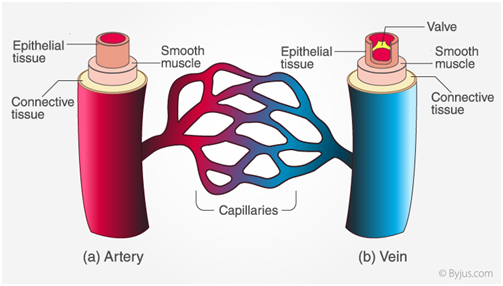BLOOD
Blood is one of the most important components of life. Almost any animal that possesses a circulatory system has blood. From an evolutionary perspective, blood was speculated to have risen from a type of cell that was responsible for phagocytosis and nutrition. Billions of years later, blood and the circulatory system have drastically helped the evolution of more complex lifeforms.
| Table of Contents |
|---|
| Types Of Blood Cells |
What is Blood? |
|---|
Blood is a fluid connective tissue that consists of plasma, blood cells and platelets. It circulates throughout our body delivering oxygen and nutrients to various cells and tissues. It makes up 8% of our body weight. An average adult possesses around 5-6 litres of blood. |
Types of Blood Cells
We have seen blood consist of cells known as formed elements of blood. These cells have their own functions and roles to play in the body. The blood cells which circulate all around the body are as follows:
Red blood cells (Erythrocytes)
RBCs are biconcave cells without nucleus in humans; also known as erythrocytes. RBCs contain the iron-rich protein called haemoglobin; give blood its red colour. RBCs are the most copious blood cells produced in bone marrows. Their main function is to transport oxygen from and to various tissues and organs.
White blood cells (Leucocytes)
Leucocytes are colourless blood cells. They are colourless because it is devoid of haemoglobin. They are further classified as granulocytes and agranulocytes. WBCs mainly contribute to immunity and defence mechanism.
Red Blood Cells are red due to Hemoglobin, which is a transport molecule and also a pigment. As a result, blood is red.
Types of White Blood Cells
There are five different types of White blood cells and are classified mainly based on the presence and absence of granules.
Granulocytes
Agranulocytes

There are five types of white blood cells present in the blood
Granulocytes
They are leukocytes, with the presence of granules in their cytoplasm. The granulated cells include- eosinophil, basophil, and neutrophil.
Eosinophils
They are the cells of leukocytes, which are present in the immune system.
These cells are responsible for combating infections in parasites of vertebrates and for controlling mechanisms associated with allergy and asthma.
Eosinophil cells are small granulocyte, which are produced in the bone marrow and makes 2 to 3 per cent of whole WBCs. These cells are present in high concentrations in the digestive tract.
Basophils
They are the least common of the granulocytes, ranging from 0.5 to 1 per cent of WBCs.
They contain large cytoplasmic granules, which play a vital role in mounting a non-specific immune response to pathogens, and allergic reactions by releasing histamine and dilating the blood vessels.
These white blood cells have the ability to be stained when exposed to basic dyes, hence referred to as basophil.
These cells are best known for their role in asthma and their result in inflammation and bronchoconstriction in the airways.
- They secrete serotonin, histamine and heparin.
Neutrophils
They are normally found in the bloodstream.
They are predominant cells, which are present in pus.
Around 60 to 65 per cent of WBCs are neutrophils with a diameter of 10 to 12 micrometres.
The nucleus is 2 to 5 lobed and the cytoplasm has very fine granules.
Neutrophil helps in the destruction of bacteria with lysosomes, and it acts as a strong oxidant.
Neutrophils are stained only using neutral dyes. Hence, they are called so.
Neutrophils are also the first cells of the immune system to respond to an invader such as a bacteria or a virus.
The lifespan of these WBCs extends for up to eight hours and is produced every day in the bone marrow.
Agranulocytes
They are leukocytes, with the absence of granules in their cytoplasm. Agranulocytes are further classified into monocytes and lymphocytes.
Monocytes
These cells usually have a large bilobed nucleus, with a diameter of 12 to 20 micrometres.
The nucleus is generally half-moon shaped or kidney-shaped and it occupies 6 to 8 per cent of WBCs.
They are the garbage trucks of the immune system.
The most important functions of monocytes are to migrate into tissues and clean up dead cells, protect against bloodborne pathogens and move very quickly to the sites of infections in the tissues.
These white blood cells have a single bean-shaped nucleus, hence referred to as Monocytes.
Lymphocytes
They play a vital role in producing antibodies.
Their size ranges from 8 to 10 micrometres.
They are commonly known as natural killer cells.
They play an important role in body defence.
These white blood cells are colourless cells formed in lymphoid tissue, hence referred to as lymphocytes.
There are two main types of lymphocytes – B lymphocytes and T lymphocytes.
These cells are very important in the immune systems and are responsible for humoral and cell-mediated immunity.
Platelets (Thrombocytes)
Thrombocytes are specialized blood cells produced from bone marrow.
Platelets come into play when there is bleeding or haemorrhage.
They help in clotting and coagulation of blood. Platelets help in coagulation during a cut or wound.

Composition of Blood: Plasma, RBCs, WBCs and platelets
Components Of Blood
There are many cellular structures in the composition of blood. When a sample of blood is spun in a centrifuge machine, they separate into the following constituents: Plasma, buffy coat and erythrocytes. Thus blood contains RBC, WBC, platelets and plasma.

Plasma
The liquid state of blood can be contributed to plasma as it makes up ~55% of blood. It is pale yellow in colour and when separated. Blood plasma consists of salts, nutrients, water and enzymes. Blood plasma also contains important proteins and other components necessary for overall health. Hence, blood plasma transfusions are given to patients with liver failure and life-threatening injuries.
Components of Blood Plasma
Blood plasma has several protein components. Proteins in blood plasma are:
- Serum globulin
- Serum albumin
- Fibrinogen
The serum contains only globulin and albumin. Fibrinogen is absent in serum because it is converted into fibrin during blood clotting.
Red Blood Cells (RBC)
Red blood cells consist of Haemoglobin, a protein. They are produced by the bone marrow to primarily carry oxygen to the body and carbon dioxide away from it.
White Blood Cells (WBC)
White blood cells are responsible for fighting foreign pathogens (such as bacteria, viruses, and fungi) that enter our body. They circulate throughout our body and originate from the bone marrow.
Platelets
Tiny disc-shaped cells that help regulate blood flow when any part of the body is damaged, thereby aiding in fast recovery through clotting of blood.
The above-stated elements form the composition of blood in humans. The only vertebrate without haemoglobin is the crocodile icefish. It derives its oxygen requirement directly from the cold, oxygen-rich water where it lives.
Also Read: Difference between Plasma and Serum
Blood Vessels
There are different types of blood vessels in our body each carrying out specialized functions.
Types of Blood Vessels
Three types of blood vessels are:
Arteries
Veins
Capillaries
Arteries
Arteries are strong tubes and muscular in nature. These blood vessels carry oxygen-rich blood from the heart to all the tissues of the body. Aorta is one of the main arteries that arise from the heart and branches further.
Veins
Veins are elastic blood vessels which carry deoxygenated blood from all parts of the body to the heart. An exception is the umbilical and pulmonary veins. The Pulmonary vein carries oxygenated blood to the heart from the lungs and the umbilical vein carries oxygenated blood from the placenta to the foetus.
Capillaries
On reaching tissues, arteries branch further into extremely thin tubes called capillaries. Capillaries bring about the exchange of substances between blood and tissues.
Sinusoids
Sinusoids are a special type of wider capillaries present in bone marrow, liver, lymph nodes, spleen and some endocrine glands. They may be continuous, discontinuous or fenestrated.
Layers of Blood Vessels
Both arteries and veins consist of three layers.
Tunica Intima: It is one of the innermost and thinnest layers of arteries and veins. It comprises endothelial cells. They are in direct contact with the flow of blood.
Tunica Media: It is the middle layer of an artery or vein. Tunica media is made up of smooth muscle cells.
Tunica Externa: It surrounds tunica media. It is made up of collagen and is also supported by the elastic lamina in arteries.
Functions of Blood
Blood is responsible for the following body functions:
Fluid Connective Tissue
Blood is a fluid connective tissue composed of 55% plasma and 45% formed elements including WBCs, RBCs, and platelets. Since these living cells are suspended in plasma, blood is known as a fluid connective tissue and not just fluid.
Provides oxygen to the cells
Blood absorbs oxygen from the lungs and transports it to different cells of the body. The waste carbon dioxide moves from the blood to the lungs and is exhaled.
Transports Hormones and Nutrients
The digested nutrients such as glucose, vitamins, minerals, and proteins are absorbed into the blood through the capillaries in the villi lining the small intestine.
The hormones secreted by the endocrine glands are also transported by the blood to different organs and tissues.
Homeostasis
Blood helps to maintain the internal body temperature by absorbing or releasing heat.
Blood Clotting at Site of Injury
The platelets help in the clotting of blood at the site of injury. Platelets along with the fibrin form clot at the wound site
Transport of waste to the Kidney and Liver
Blood enters the kidney where it is filtered to remove nitrogenous waste out of the blood plasma. The toxins from the blood are also removed by the liver.
Protection of the body against pathogens
The White Blood Cells fight against infections. They multiply rapidly during infections.





Comments
Post a Comment